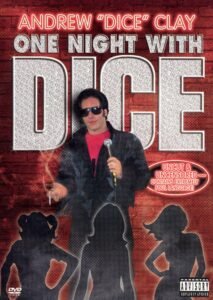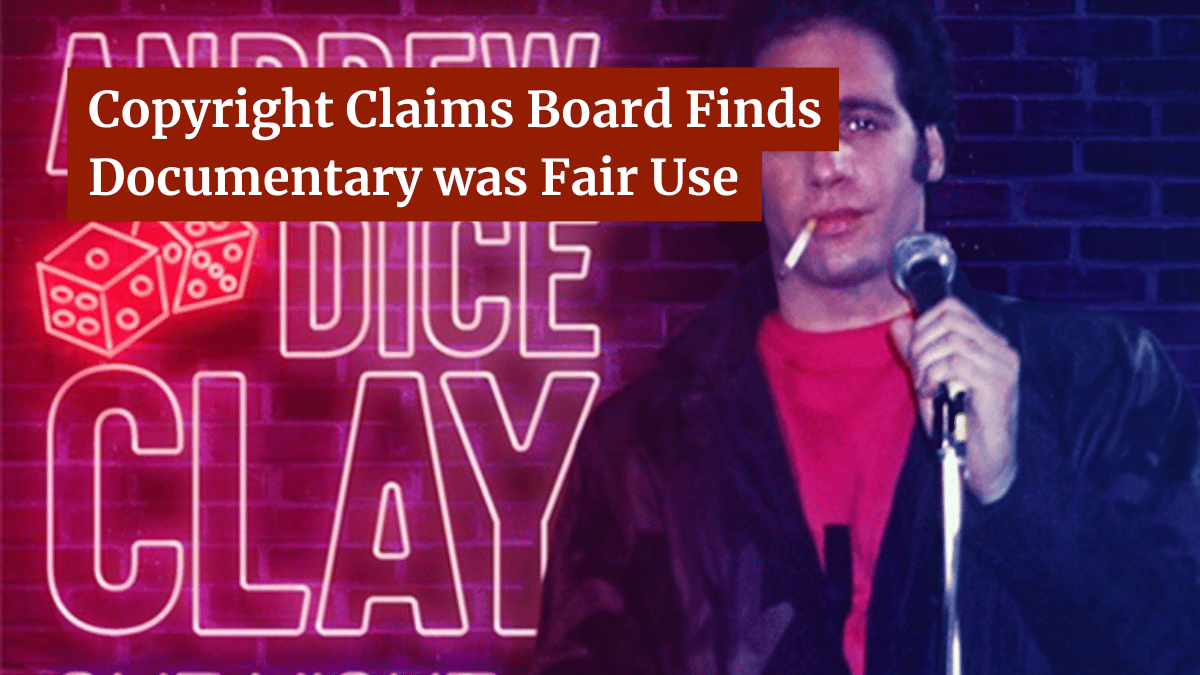Copyright Claims Board Finds Documentary was Fair Use

The claim was filed by Comedy Spotlight Productions Inc., the owners of the 1986 Andrew Dice Clay stand-up comedy special One Night with Dice. They had filed the claim against Store on Sunset LLC, which had produced a five-part documentary series entitled The Comedy Store.
In episode three of that series Store on Sunset includes two clips from the One Night with Dice special. The first, a five-second clip, was not contested but the second. However, the second clip, which was over 12 seconds, featured an entire joke from the special, which ended with Dice using a homophobic slur.
Comedy Spotlight Productions argued that the clip used more than necessary from the special and should have licensed the clip. Store on Sunset, however, argued that the use was a fair use and using the whole joke was necessary to make the point about how such slurs hurt Dice’s career.
On Friday the CCB handed down its final determination in the case, siding with Store on Sunset in finding that the use was indeed a fair use. The case is a complete win for Store on Sunset, with the claim being dismissed with prejudice. However, another respondent that defaulted in the matter only had their claims dismissed without prejudice.
Though the ruling is reasonably straightforward, it still provides interesting insight into how the CCB is likely to treat future fair use cases and what we can expect from the board moving forward.
Understanding the CCB’s Determination
Since the facts of the case were not really in dispute, the only issue before the board was whether the use was a fair use.
To determine that, the board examined the four fair use factors:
- The purpose and character of the use, including whether such use is of a commercial nature or is for nonprofit educational purposes;
- The nature of the copyrighted work;
- The amount and substantiality of the portion used in relation to the copyrighted work as a whole;
- And the effect of the use upon the potential market for or value of the copyrighted work.
The board found that the first factor strongly favored Store on Sunset. Though the board acknowledged that the use was a commercial use, it highlighted that the purpose was strictly for commentary and criticism of the original work. They further found that the documentary served a different function, namely to critique, than the original work, which was meant solely to entertain.
On the second factor, the board found that it was neutral but that “This factor is almost negligible when the use of the creative work is for a clear transformative purpose such as criticism or commentary.” In short, the board found that the transformative nature of this use made the second factor almost useless for analysis.
Regarding the third factor, the board found the “amount and substantiality” weighed heavily in favor of Store on Sunset, noting that it was only 18 seconds total of a 46-minute work, equaling less than 1% of the work in whole. They found that the proposed use of the slur without the joke leading up to it was “nonsensical.”
Finally, on the fourth factor, the board found that there was no evidence that the documentary had harmed the market for the work, noting that there was little evidence that there was any market for clips from the original work.
With all four factors examined, the board found that they weighed significantly in favor of Store on Sunset, opting to dismiss the claim against them with prejudice.
What’s Interesting About the Determination
Though only 8 pages long, the final determination spends over half of those pages on the fair use questions and that gives us a good look at the mindset of the CCB when it comes to fair use questions.
One thing that surprised me is that the CCB did not cite that Warhol ruling at all. Even though it is the most recent ruling by the Supreme Court on fair use and one that directly alters the nature of transformativeness as a factor in fair use, it was not mentioned, positively or negatively.
The previous big case, Campbell v. Acruff-Rose, was mentioned five times in the degermation. That case, which is from 1994, is the one that established transformativeness as the most important factor when determining fair use, something the Warhol case tried to limit.
Other courts, including the Fourth Circuit Court of Appeals, have drastically shifted their views on fair use because of the Warhol ruling. The CCB, however, seems more unfazed.
Second is the time frame for this whole case. The original claim was filed in late January 2023 and the final determination was handed down in early March 2024. That is just over one year to complete the case and that time includes delays for one party defaulting and delays over evidence.
While a year is not a short period of time, compared to how long a similar case would have likely taken before a federal court, it is extremely quick. Many federal cases are considered quick if they are settled in a year. This one made it all the way to a final determination.
Finally, it is also interesting how the board handled the second respondent, MAKE GOOD Content. Make Good was served and, according to the original claim, was jointly liable with Store on Sunset. However, they never responded to the claim and ended up defaulting.
Under the board’s policies, it dismissed the claims against Make Good, but only without prejudice, meaning that they can be refiled in a federal court. While it is unlikely that this is something Comedy Spotlight would do, the goal is to deter respondents from defaulting on CCB proceedings and encourage participation.
In short, if you do not participate in a CCB case, you do not gain the benefit of a CCB ruling in your favor if a co-respondent does participate and get a win.
Bottom Line
In the end, I agree with the CCB’s decision. I feel that, even in the post-Warhol world, there was a compelling argument in favor of fair use. While I understand the complexities of licensing clips for a documentary, I think the CCB landed on the right side in this case, even if I can also understand how/why others would disagree.
That said, I do wish the CCB had done more to address the Warhol ruling and provide insight into why it leaned so heavily into transformativeness even after the Supreme Court handed down a decision aimed at checking its weight and influence.
In short, I think it was the right decision, but I worry that the reasoning is outdated when stacked against more recent Supreme Court decisions. Hopefully, this is something that the board can remedy in future cases.
This should be easy for the board to do as CCB cases are not precedent either to outside courts or within the CCB itself. While such determinations give us a look into the mindset of the board, they are not something that the board is locked into either.
That leaves room for the board to change its approach in future determinations, something that is likely given the growing impact of the Warhol ruling.
Want to Reuse or Republish this Content?
If you want to feature this article in your site, classroom or elsewhere, just let us know! We usually grant permission within 24 hours.
